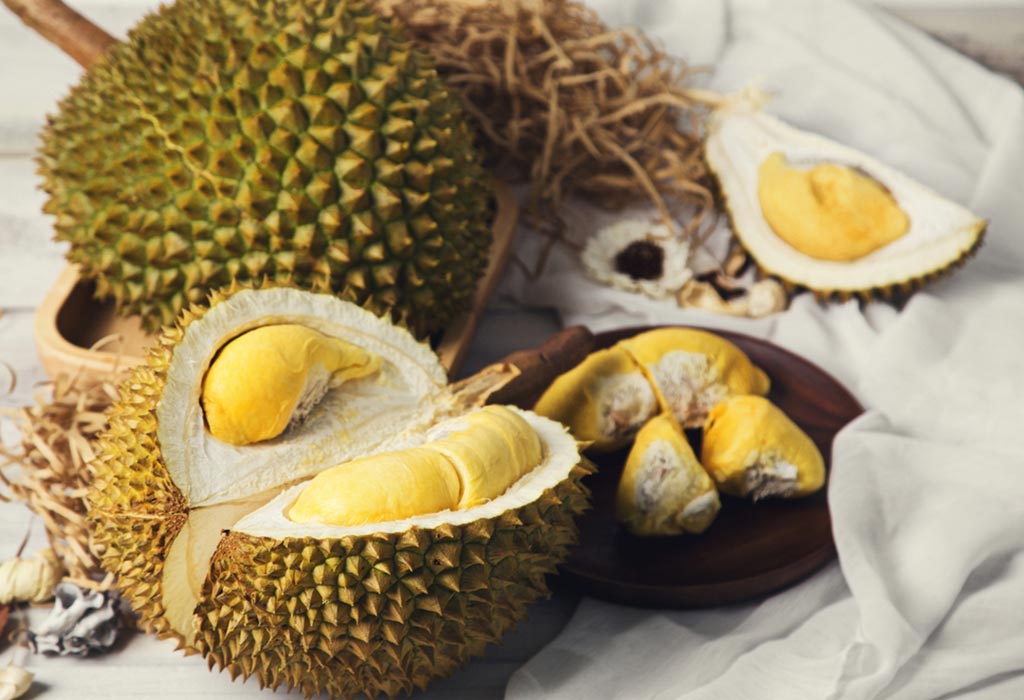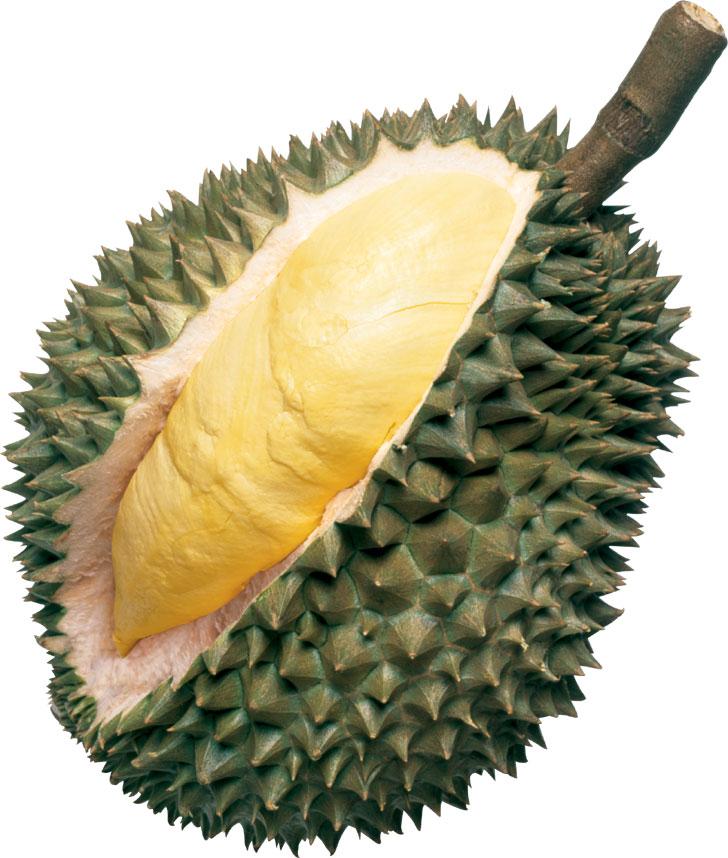Exploring the Nutritional Contents and Benefits of Durian (Durio zibethinus)
Descriptions
King of fruits
Durian is the fruit of several tree species belonging to the genus Durio. There are about 30 recognized Durio species, however, at least nine of which produce edible fruits. Durio zibethinus is the only species available in the international market: other species are sold in their local regions. Durio zibethinus or locally known as durian is belonged to the family of Bombacaceae, or by others in a broadly defined Malvaceae or by others in a smaller family of just seven genera Durionaceae. Durian is native to Southeast Asia. It is found wild or semi-wild in South Tenasserim, lower Burma and around villages in peninsular Malaysia. In addition, the wild durian widely planted in Borneo and Sumatra. Borneo is the center for the diversity of Durio species. Durian is commonly cultivated along roads or in commercial orchards in Thailand, Laos, Vietnam, Malaysia, Brunei, Indonesia and Philippines. Apart from durian, this species also well-known with other common names such as Civet-Cat Fruit Tree, Civet fruit, Kampung Durian as called in English, Dian, Durian Puteh and Jatu called in Borneo, Liu Lian as called in Chinese, Dereyan called by Indonesian and etc (Lim, 2012).
Durian thrives in a hot, humid and wet climate with an average annual temperature of 24-30 ̊C, the relative humidity of 75-90%. Durian needs well-distributed rainfall.
However, a relatively dry spell stimulates and synchronizes flowering. Durian species thrive best in lowlands as it does not grow well and produce fruits above 800 m altitude. Durian grows best in a well-drained and fertile soil rich in organic matters that have a pH range from 5-6.5. Durian is intolerant of water logging which will cause destructive fungal root and trunk rot diseases. Furthermore, durian cannot withstand more than 0.02 % of salinity in the soil (Lim, 2012).
The durian tree can reach up to 27-40 m in height in tropical forests. Durian tree usually erect with short, straight, rough, peeling trunk to 1.2 m in diameter and have an umbrella-shaped canopy of rough branches and thin branchlets coated with coppery or gray scales when young. The evergreen, alternate leaves are oblong, elliptic or rounded at the base, abruptly pointed at the apex; leathery, dark-green and glossy above, silvery or pale-yellow, and densely covered with gray or reddish-brown, hairy scales on the underside. The fruits are ovoid or ovoid-oblong to nearly round and up to 8 kg in weight. The yellow or yellowish-green rind is thick, tough, semi-woody, and densely set with stout, sharply pointed spines, 3- to 7-sided at the base. Inside there are 5 compartments containing the creamy-white, yellowish, pinkish or orange-coloured flesh and 1 to 7 chestnut-like seeds (Morton, 1987).
Nutritional Value of Durian’s Edible Part
Nutrient Value per 100 g
Physical & Biochemical Analysis
| Water – 64.99 g | Energy – 147 kcal |
| Protein – 1.47 g | Total lipid(fat) – 5.33 g |
| Ash – 1.12 g | Carbohydrates – 27.09 g |
| Fiber, total dietary – 3.80 g | Calcium, Ca – 6.000 mg |
| Iron, Fe – 0.430 mg | Magnesium, Mg – 30.000 mg |
| Phosphorus, P – 39.000 mg | Potassium, K – 436.000 mg |
| Sodium, Na – 2.000 mg | Zinc, Zn – 0.280 mg |
| Copper, Cu – 0.207 mg | Manganese, Mn – 0.325 mg |
| Vitamin C, total ascorbic acid – 19.700 mg | Thiamin – 0.374 mg |
| Riboflavin – 0.200 mg | Niacin – 1.074 mg |
| Pantothenic acid – 0.230 mg | Vitamin B6 – 0.316 mg |
| Folate, total – 36 µg | Vitamin B12 – 0 µg |
| Vitamin A, RAE – 2 µg | Retinol – 0 µg |
| Carotene, beta – 23 µg | Carotene, alpha – 6 µg |
| Cryptoxanthin, beta – 0 µg | Vitamin A, IU – 44 IU |
| Cholesterol – 0 mg |

Durian as a Source of Food
Generally, durian is consumed fresh as fruit or food products such as candy, ice cream and durian puffs after certain cooking procedures. Traditionally, durian flesh is added into dishes such as “sayur” which is the Indonesian soup made from freshwater fish as an ingredient (Rudrappa, 2015). Moreover, the durian-based sauce is used to cook “Ikan brakes”, a traditional dish in Sumatran islands, Indonesia.
Overripe durian pulps are processed to become durian paste in Thailand while unripe durian may be cooked as a vegetable (Rudrappa, 2015; Utilization of durian, n.d.). Beside the flesh, durian seeds are also valuable as they can be eaten after boiling or roasting and made into durian flour and chips (Agus, 2014). Furthermore, the young leaves and shoots of durian plant can be cooked as green vegetables as mentioned by Wan (2010). In addition, dishes such as “pulut durian” and “tempoyak” are served together with durian (Clark’s Nutrition, 2015).

Health Benefit of Durian
Durian is widely celebrated for its long list of health benefits, which include the ability to boost the immune system, prevent cancer and inhibit free radical activity, improve digestion, strengthen bones, improve signs of anemia, prevent premature aging, lower blood pressure, and protect against cardiovascular diseases. Some of the more minor benefits of durian are to reduce inflammation of the joints, help thyroid health, reduce headaches, and lower symptoms of depression, anxiety, and stress.
Most of the health benefits come from durian’s impressive vitamin and mineral content. Durian contains vitamins such as vitamin-C, folic acid, thiamin, riboflavin, niacin, B6 and vitamin A. Important minerals such as potassium, iron, calcium, magnesium, sodium, zinc, phosphorus are also found in durian. It also contains nutrients such as phytonutrients, water, protein and beneficial dietary fiber.
Relieves anaemia and promotes healthy pregnancy
Anaemia is a medical condition that reduces the level of hemoglobin in blood. Deficiency in hemoglobin can lead to fatigue, headache, insomnia and etc. In pregnant woman, anaemia can lead to abnormality and fatality of the foetus. Durian contains high amount of folate or folic acid which is essential in the production of haemoglobin. Besides that, low content of iron in durian aids in haemoglobin production alleviating condition of anaemia (Kevat, 2013). Furthermore, presence of folate in durian is important for pregnant woman as it promote regular tissue growth as well as protects the brain and spine in developing baby (Health benefits of durians, 2015).
Helps to maintain healthy bones
Durian contains a number of trace metals including calcium and potassium. Even calcium is present in low level in durian, but amount of potassium present in durian fulfils about 9 % of our body’s daily requirement. Potassium is required for the development of healthy bones. Even though the most abundant mineral of our bone is calcium, but potassium is crucial to regulate the distribution and deposition of the calcium in bones so that it is not dissolved or released into the blood excessively (Kevat, 2013).
Helps to alleviate depression and improves sleep
Durian contains amino acids known as tryptophan – a natural sleep-inducing compound. Tryptophan is required to increase the level of serotonin and melatonin. These two neuro-chemicals are required to manage our emotions. Serotonin is essential to relieve stress, sleeplessness, anxiousness, appetite as well as depression. In addition, these types of hormones help to manage sleeping function and could be utilized in the epilepsy cure (Kevat, 2013).
Fight cancer
Durian has a wealth of vitamins, nutrients, and organic chemicals that function as antioxidants. In the battle against cancer, free radicals are vitally important, because during cell metabolism, there are by-products created, called free radicals. These free radicals can destroy the DNA of regular cells and convert them into cancer cells, which can then metastasize or form fatal, tumorous growths. All of the antioxidants which reduce oxidative stress on the organs of the body are bonuses to the immune system, and durian is packed with them, including vitamin-C, vitamin-B complex, and vitamin E, as well as phytonutrients that battle cancerous cells (Health benefits of Durian, 2015).
Aids in digestion
Durian contains high levels of dietary fibre, which are important for the normal function of the digestive system. Fibre causes bowel movement to increase in bulk, which makes it easier for them to move through the intestinal tract. Fibre also stimulates peristaltic motion and the secretion of digestive and gastric juices, further easing the entire process. By reducing conditions like constipation and blockage in the intestines, conditions like bloating, excess flatulence, heartburn, cramps, and indigestion as well as colorectal cancer can be minimized. Much of the fibre in durian is insoluble fibre, which also lowers the frequency of diarrhea for people with loose stool. Fibre also helps to reduce the amount of cholesterol in the blood by scraping LDL cholesterol out of the body and quickly removing it before it can do any damage to the cardiovascular system (Health benefits of Durian, 2015).
Anti-aging
Durian has a wide variety of antioxidant properties stemming from its vitamin and organic chemical makeup that actively reduce the amount of free radicals in the body. Eating an excessive amount of durian can seriously boost your body’s ability to eliminate those free radicals, thereby reducing the chances of premature aging and delaying the appearance of symptoms such as wrinkles, age spots, macular degeneration, hair loss, tooth loosening, arthritis, cancer, and heart disease (Health benefits of Durian, 2015). In addition, the high water content of Durian is an added advantage along with its antioxidant content. Water keeps the skin hydrated, reduces dryness and alleviates the appearance of fine lines. It also nourishes skin for clear and smooth skin (Kevat, 2013).
Increase and encourage fertility
Estrogen is a hormone that helps in conceiving. Most of the women who suffer from fertility usually have a low estrogen level in their body which is increased with pills, injections and supplements. Studies have shown that durian contains a high level of this hormone and can act as an herbal medicine (Kevat, 2013). Besides that, durian can produce intensified sexual libido and stamina, and also reduce the chances of infertility in men and women, and increase sperm motility (Health benefits of Durian, 2015).
Used as traditional medicine
According to traditional use, durian may have antibacterial, anti-inflammatory, and vasoconstrictor properties. Traditionally, durian leaves and roots are in Malaysia used to treat fever. The juice of fresh leaves is used as an ingredient in a lotion for fevers, and the juice from the bark is used as an antimalarial in Sumatra. The Javanese also believe that durian has aphrodisiac properties. In addition, durian leaves are considered anthelmintic and are used for jaundice treatment. Decoctions of the leaves and fruits are used to treat swelling and skin conditions (Clark’s Nutrition, 2011).
Other Uses
On the other hand, durian can be used for purposes other than foods and medicines. Durian husks which are usually thrown as wastes after the durian pulps are consumed can be dried to be used as fuel or fertilizers for tree (Utilization of durian, n.d.). It can also be used as an ingredient for making handmade paper like artistic paper with certain pattern (Agus, 2014). Due to the strong smell, durian husks can be used as the natural mosquitoes repellent. Dr. S. Kathiresan from AIMST University discovered that durian peel can be used as a mean to recover the oil spill at coastal areas (Lim, 2011). In this case, the durian peel powder is chemically modified and acts as the efficient oil absorbent to remove the oil from the water, solving the problem of oil spills which have caused adverse effects to living sea organisms and human economic activities. According to Wan (2010), woven souvenirs such as beautiful photo album covers can now be made by using the fibers of the durian plant. Meanwhile, the polysaccharides present in the large and thick durian husk were found to possess moisturization benefits and able to trap lipids and thus durian husk has the potential to be used as the ingredient for cosmetic products (Bird, 2010). In this context, more researches are required to be done on the cosmetics potential of durian husk.
Review on Durian Consumption
Durians are abundant in Asia during their season as Malaysia, Indonesia and Thailand are the world’s main durian producers. In this case, numerous surveys and reviews have been done on the nutritional values and health benefits of durian. Undeniably, durian has offered unlimited benefits to human health such as relieving anemia, alleviating depression and enhancing fertility (Health benefits of durian, 2015; Kevat, 2013).
The Swiss Society of Food Science and Technology also discovered that the levels of antioxidants content in durian are higher as compared with other Asian fruits like mango, lychee and mangosteen of similar ripeness (Durians-‘Heaty’ or healthy, n.d.). However, overconsumption of durian can bring adverse effects to consumer especially pregnant women, diabetic patients as well as obese people. As mentioned by Dr. Patrick Chia, a fetal medicine specialist in Malaysia, it is safe for woman to consume durian during pregnancy but pregnant woman with gestational diabetes must avoid eating durian due to the high sugar content (Chia, 2015). Besides, consumption of durian during last trimester of pregnancy may result in overweight fetus with greater risk of childhood obesity as durian is high-glycaemic food (Lim, 2014). Apart from that, durian contains high amount of fat and triple amount of calories as compared to other fruits where obese people should avoid (Durians-‘Heaty’ or healthy, n.d.).
From traditional Chinese medicine (TCM) perspective by Mr. Chew Hong Gian, a TCM physician at Raffles Chinese Medicine, durian is said to possess “warming” property whereby overindulgence in durians can induce sore throat, phlegmy cough and constipation or even fever (Poon, n.d.). While from the perspective of western medicine, Dr. Michael Wong as a deputy medical director of Raffles Medical reported that one’s body temperature may be increased slightly from eating durians but that does not lead to fever, coughs or respiratory infections.
In conclusion, durians offer unquestionable benefits to us but it can cause harms to our body if consumed overdose. Hence, durian lovers should consume durians on moderation to avoid health problems. Not only that, there are still many uncertainties on the uses of durian fruits other than as a source of food. Therefore, more research needed to be conducted.
Potential Research
Design a packaging that can deter the odour of durian during transportation.
Recommend mixed systems where wide-range of different fruit tree species are grown to counterbalance the climate sensitivity of individual species and ensure higher productivity of durian.
Improvement in pre- and post-harvest technologies to extend the shelf life of both fresh and minimally processed products of durian.
Improvement in storage technologies to ensure successful diversification of export markets for Malaysia.
Determine the components in durian husk that have the potential to be used in various products such as cosmetic.
Implement practical and effective integrated pest management strategies to reduce the use of chemicals, pest and diseases damages as well as the pesticides residue on the fruits.
References
- Agus, F. (2014). Unique facts and benefits of durians. Retrieved from http://agusfanani.hubpages.com/hub/EnjoyDurianFeastSavely
- Bird, K. (2010). Husks of popular Thai fruit could hold cosmetics potential. Retrieved from http://www.cosmeticsdesignasia.com/FormulationScience/HusksofpopularThaifruitcouldholdcosmeticspotential
- Chia, P. (2015). Is it safe to eat durian in pregnancy? Retrieved from http://www.babycenter.com.my/x1022992/is-it-safe-to-eat-durian-in-pregnancy
- Durians-‘Heaty’ or healthy? (n.d.). Men’s Health Singapore. Retrieved from http://www.menshealth.com.sg/weightlossnutrition/duriansheatyorhealthy
- Clark’s Nutrition. (2015). Durian (Durio zibethinus). Retrieved from http://www.clarksnutrition.com/ns/DisplayMonograph.asp? StoreID=2691b1fe187d41acb869a85ca5957a0a&DocID=bottomlinedurian
- Health benefits of durian. (2015). Retrieved from https://www.organicfacts.net/health-benefits/fruit/health-benefits-of-durian.html.
- Health benefits of durians. (2015). Retrieved from http://www.healthbenefitstimes.com/health-benefits-of-durians/.
- Kevat, D. (2013). Durian fruit health benefits and nutritional facts. Retrieved from http://wiki-fitness.com/durian-fruit-health-benefits/.
- Lim, G. (2014). Can I eat durians during pregnancy? Retrieved from http://www.gynegordon.com.sg/can-i-eat-durians-during-pregnancy/
- Lim, T. K. (2012). Edible medicinal and non-medicinal plants. New York, London: Springer.
- Lim, W. L. (2011, May 2). Durian peel can help clear oil spills: Academic. The Singapore Straits Times. Retrieved from http://www.aimst.edu.my/faculties/applied_sciences/media/4.The_Singapore_StraitTimes_May_2_2011.pdf
- Morton, J. (1987). Durian: Durio zibethinus L. retrieved from http://www.hort.purdue.edu/newcrop/morton/durian_ars.html.
- Rudrappa, U. (2015). Durian fruit nutrition facts. Retrieved from http://www.nutritionandyou.com/durianfruit.html
- Poon, C. H. (n.d.). 5 durian health myths dispelled. Men’s Health Singapore. Retrieved from http://www.menshealth.com.sg/health/5durianhealthmythsdispelled
- United States National Agricultual Library. (2015). USDA national nutrient database for standard reference release 27.
- Utilization of durian. (n.d.). Retrieved from www.dit.go.th/agriculture/durian/utilize.htm
- Wan, N. H. (2010). Durian. Retrieved from http://www.bl.uk/onlinegallery/onlineex/spicetrail/durian/.



